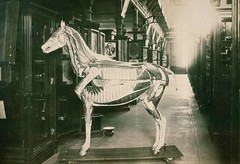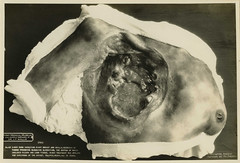An unofficial blog about the National Museum of Health and Medicine (nee the Army Medical Museum) in Silver Spring, MD. Visit for news about the museum, new projects, musing on the history of medicine and neat pictures.
Showing posts with label moulage. Show all posts
Showing posts with label moulage. Show all posts
Wednesday, July 21, 2010
Moulage kit
Jim Curley aka "niceguy", showed me some cool stuff from his historical collection,
its always fun to interact with Jim, he knows his stuff... as you walk into hammond hall the 12"floor to ceiling stacks of out of date medical instruments from the banal to bizarre in powder blue cabinets, labeled with wierd notes like... stop playing with this stuff or you'll go blind...
you start to have expectations of seeing something extrooordinary (said like the monarch) This moulage kit was from the 50's, my favorite inside is the atomic burn face. probably unlikey to
encounter this ever, but at least i know what to look for. doubt you could help that victim out unless its just sunburn and then you can hand em a can of cocoabutter.
Thanks to Jim C
NC out
Moulage kit from the museums historical collection
Friday, August 8, 2008
Military medicine training article
Speaking of moulages and training, here's an article that talks about their current use. "Trial by (Simulated) Fire: Military Doctors Learn to Practice Wartime Medicine on Mock Battlefield," By Philip Rucker, Washington Post Staff Writer, Friday, August 8, 2008; B01. I met the doctor who's quoted at the end, Capt. Trueman Sharp, last year when the museum got a collection of Vietnam-era medical data from his department for scanning - the Wound Data Munitions Effectiveness Team (WDMET) records include wounding information, x-rays, 35mm slides and sometimes fragments. We've got the material being scanned now, but it's going to take a while to finish.
Monday, August 4, 2008
Moulage instruction booklet
As mentioned a couple of days ago, here's an instruction book for moulages meant to simulate mass casualties - Instructor's Guide for Casualty Simulation Kit Device 11E10
Tuesday, July 29, 2008
Let's look at a photo
This one's for Johanna of the Morbid Anatomy blog - she's seen this picture before, but let's take a look at it.

Comparative anatomy, Auzoux model of horse, life size. Specimen no. 2635. [papier mache, on display in Army Medical Museum]. We no longer have the model, although one can be seen in the Science Museum in London.
For many years, models were a way to convey information in medicine and natural sciences. Color printing had to be hand-done, and photography first didn't exist, and then each photograph for a book had to be printed individually and glued into the book. And hand-tinted if required. So well into the 20th century models like Auzoux's above, or ones like this x-ray burn were produced for education.

Breast. Burn, X-Ray. Wax model. No. 92 X-ray burn involving right breast and axilla. Necrosis of tissue producing sloughing ulceration, the bottom of which includes pleura and lung tissue. X-ray treatment was applied for carcinoma of the breast. Colored, woman, age 35 years. Army Medical Museum model prepared by Dr. J.F. Wallis. [Circa World War 1, 1918].
The museum's model-making skills continued into the 1950s, when a technique called moulage, which simulated injuries in rubber overlays were developed. A soldier would put on a moulage of a nuclear radiation injury for example and then the trainees would attempt to treat him. I'll attempt to get some photographs of them up, although I think we scanned the kit's whole instruction book recently as well.
Check out this conference in Europe on models and Auzoux too.

Comparative anatomy, Auzoux model of horse, life size. Specimen no. 2635. [papier mache, on display in Army Medical Museum]. We no longer have the model, although one can be seen in the Science Museum in London.
For many years, models were a way to convey information in medicine and natural sciences. Color printing had to be hand-done, and photography first didn't exist, and then each photograph for a book had to be printed individually and glued into the book. And hand-tinted if required. So well into the 20th century models like Auzoux's above, or ones like this x-ray burn were produced for education.

Breast. Burn, X-Ray. Wax model. No. 92 X-ray burn involving right breast and axilla. Necrosis of tissue producing sloughing ulceration, the bottom of which includes pleura and lung tissue. X-ray treatment was applied for carcinoma of the breast. Colored, woman, age 35 years. Army Medical Museum model prepared by Dr. J.F. Wallis. [Circa World War 1, 1918].
The museum's model-making skills continued into the 1950s, when a technique called moulage, which simulated injuries in rubber overlays were developed. A soldier would put on a moulage of a nuclear radiation injury for example and then the trainees would attempt to treat him. I'll attempt to get some photographs of them up, although I think we scanned the kit's whole instruction book recently as well.
Check out this conference in Europe on models and Auzoux too.
Monday, March 10, 2008
the military's medical school
Our colleagues in Bethesda at the Uniformed Services University of the Health Sciences made it into the Post today - see "Today's Lesson: Major Disaster - Military Medical School Simulates Chaotic Situations," By Jackie Spinner, Washington Post Staff Writer
Monday, March 10, 2008; Page B04. Interestingly enough, the moulage techniques being used in this picture were developed by an Army Medical Museum staffer, Sgt. Cortizas. We've got some historical moulage kits as well as photographs and papers on the development of them including this collection:
OHA 334
* Training Aids Section Files, 1955-1963
* 3.5 cubic feet, 7 boxes.
* No finding aid, part arranged, inactive, unrestricted.
* Records of a defunct AFIP division concerned with medical training, which grew out of work done at the Museum. Includes material on films, moulages, manikins, and other training aids. Many of the products are in Historical Collections.
Monday, March 10, 2008; Page B04. Interestingly enough, the moulage techniques being used in this picture were developed by an Army Medical Museum staffer, Sgt. Cortizas. We've got some historical moulage kits as well as photographs and papers on the development of them including this collection:
OHA 334
* Training Aids Section Files, 1955-1963
* 3.5 cubic feet, 7 boxes.
* No finding aid, part arranged, inactive, unrestricted.
* Records of a defunct AFIP division concerned with medical training, which grew out of work done at the Museum. Includes material on films, moulages, manikins, and other training aids. Many of the products are in Historical Collections.
Subscribe to:
Comments (Atom)


